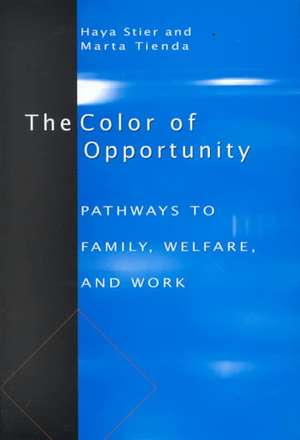The Color of Opportunity: Pathways to Family, Welfare, and Work
Autor Haya Stier, Marta Tiendaen Limba Engleză Hardback – 4 feb 2001
In The Color of Opportunity, Haya Stier and Marta Tienda ask: How do race and ethnicity limit opportunity in post-civil rights Chicago? In the 1960s, Chicago was a focal point of civil rights activities. But in the 1980s it served as the laboratory for ideas about the emergence and social consequences of concentrated urban poverty; many experts such as William J. Wilson downplayed the significance of race as a cause of concentrated poverty, emphasizing instead structural causes that called for change in employment policy. But in this new study, Stier and Tienda ask about the pervasive poverty, unemployment, and reliance on welfare among blacks and Hispanics in Chicago, wondering if and how the inner city poor differ from the poor in general.
The culmination of a six-year collaboration analyzing the Urban Poverty and Family Life Survey of Chicago, The Color of Opportunity is the first major work to compare Chicago's inner city minorities with national populations of like race and ethnicity from a life course perspective. The authors find that blacks, whites, Mexicans, and Puerto Ricans living in poor neighborhoods differ in their experiences with early material deprivation and the lifetime disadvantages that accumulate—but they do not differ much from the urban poor in their family formation, welfare participation, or labor force attachment. Stier and Tienda find little evidence for ghetto-specific behavior, but they document the myriad ways color still restricts economic opportunity.
The Color of Opportunity stands as a much-needed corrective to increasingly negative views of poor people of color, especially the poor who live in deprived neighborhoods. It makes a key and lasting contribution to ongoing debates about the origins and nature of urban poverty.
The culmination of a six-year collaboration analyzing the Urban Poverty and Family Life Survey of Chicago, The Color of Opportunity is the first major work to compare Chicago's inner city minorities with national populations of like race and ethnicity from a life course perspective. The authors find that blacks, whites, Mexicans, and Puerto Ricans living in poor neighborhoods differ in their experiences with early material deprivation and the lifetime disadvantages that accumulate—but they do not differ much from the urban poor in their family formation, welfare participation, or labor force attachment. Stier and Tienda find little evidence for ghetto-specific behavior, but they document the myriad ways color still restricts economic opportunity.
The Color of Opportunity stands as a much-needed corrective to increasingly negative views of poor people of color, especially the poor who live in deprived neighborhoods. It makes a key and lasting contribution to ongoing debates about the origins and nature of urban poverty.
Preț: 300.92 lei
Preț vechi: 350.10 lei
-14% Nou
Puncte Express: 451
Preț estimativ în valută:
57.61€ • 59.25$ • 47.79£
57.61€ • 59.25$ • 47.79£
Carte indisponibilă temporar
Doresc să fiu notificat când acest titlu va fi disponibil:
Se trimite...
Preluare comenzi: 021 569.72.76
Specificații
ISBN-13: 9780226774206
ISBN-10: 0226774201
Pagini: 264
Ilustrații: 8 maps, 38 line drawings, 47 tables
Dimensiuni: 152 x 229 x 25 mm
Greutate: 0.54 kg
Ediția:1
Editura: University of Chicago Press
Colecția University of Chicago Press
ISBN-10: 0226774201
Pagini: 264
Ilustrații: 8 maps, 38 line drawings, 47 tables
Dimensiuni: 152 x 229 x 25 mm
Greutate: 0.54 kg
Ediția:1
Editura: University of Chicago Press
Colecția University of Chicago Press
Notă biografică
Haya Stier is a senior lecturer at the Department of Labor Studies and the Department of Sociology at Tel Aviv University.
Marta Tienda is the Maurice P. During '22 Professor of Demographic Studies, professor of sociology and public affairs, and the director of the Office of Population Research at Princeton University.
Marta Tienda is the Maurice P. During '22 Professor of Demographic Studies, professor of sociology and public affairs, and the director of the Office of Population Research at Princeton University.
Cuprins
List of Illustrations
Preface
Acknowledgments
1. Poor People, Poor Places
2. Chicago: Economic and Social Transformation of an Urban Metropolis
3. The Study Population
4. Family Matters: Turning Points from Orientation to Procreation
5. Doles and Safety Nets: Public Assistance and Income Support
6. Makin' a Living: Employment Opportunity in the Inner City
7. The Contours of Opportunity
Appendix A - Design of the Urban Poverty and Family Life Survey
Appendix B - Methodological Appendix
References
Index
Preface
Acknowledgments
1. Poor People, Poor Places
2. Chicago: Economic and Social Transformation of an Urban Metropolis
3. The Study Population
4. Family Matters: Turning Points from Orientation to Procreation
5. Doles and Safety Nets: Public Assistance and Income Support
6. Makin' a Living: Employment Opportunity in the Inner City
7. The Contours of Opportunity
Appendix A - Design of the Urban Poverty and Family Life Survey
Appendix B - Methodological Appendix
References
Index
